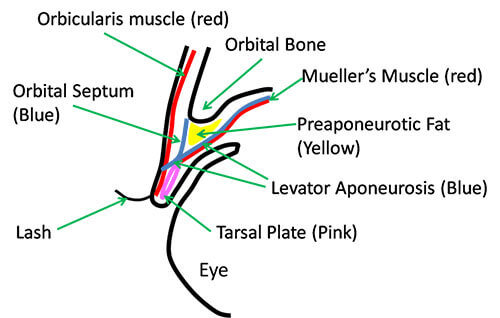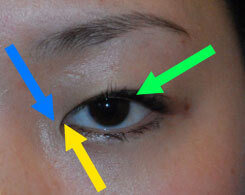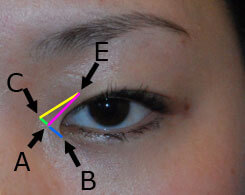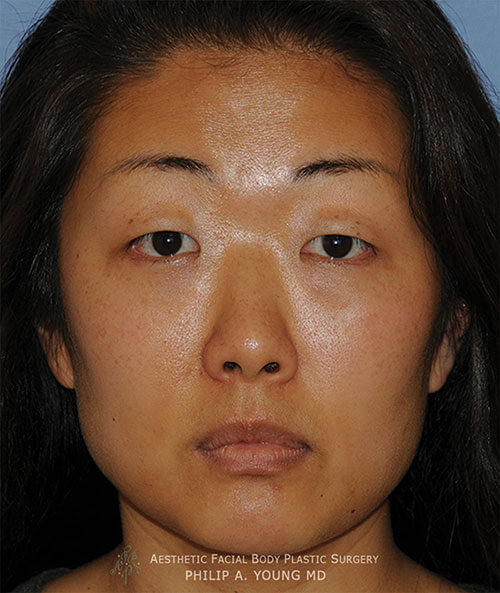Asian eyelid surgery is a unique segment of Asian plastic cosmetic surgery and concerns the formation of the double eyelid. Many Asians are born with a single eyelid fold. The eyelid skin can encroach on the eyelid margin and eyelashes and make the eye look smaller.
The creation of a double eyelid can decrease this anatomical variant and give the eye the appearance of being larger and more open. The double eyelid crease makes the eye look bigger because of the shadow it creates on the face. This shadow associates the darker iris (in contrast to the stark white sclera) to give the illusion of a bigger eye.
Dr. Young has a special technique called orbicularis levator fixation (developed by J. Park). This special approach uses a permanent stitch buried underneath the eyelid skin.
The suture attaches the levator to the orbicularis muscle. The levator muscle’s primary action elevates the eyelid margin or opens the eye and eyelid. The orbicularis muscle is superficial and responsible for closing the eye, winking, and squinting.
The orbicularis is so tightly sticks to the skin that attaching the levator to the orbicularis means connecting the levator to the skin. It allows the eyelid crease to form through this association. Being buried, there is less dependence on scar formation to form the crease and more on the action of the suture.
The crease can then last longer, be more reliable and accurate than through a traditional double eyelid creation technique, which depends on scar formation. This technique is very difficult to perform and takes many years of experience to master. Hence, only a small percentage of surgeons use this technique.

A medial epicanthoplasty widens the eyes horizontally. This type of procedure can be done through sutures or an open technique. Dr. Young can create the double eyelid crease with either approach. He prefers to create the crease with an incision in the open technique.
When the double eyelid is created through an incision, the results can be more accurate and can last much longer. With the suture technique done without significant incisions, you have a greater chance of having more variable results. Your crease can be discontinuous, relax asymmetrically, and multiple folds can be created more commonly through sutures.
The medial epicanthoplasty procedure involves the middle part of the eye and rearranging or excising tissue to give the appearance of a larger looking eye. This is done by opening up the eye mainly in the horizontal direction.
During our development, our nasal bridge rises to a certain degree. The skin at the medial part of the eyes can be brought in or left out. When this process is interrupted during our development in the womb and after birth, it can lead to a different appearance in the eye. For some Asian people, this skin is left over the medial part of the eye. This extra skin has been termed the epicanthal fold.


Note: Individual results will vary. Images do not constitute a promise or representation of any particular outcome or experience.
You can classify the epicanthal fold in many ways. Type 1 of this anatomical variant can be found in Caucasian people when there is no epicanthal fold. Type 2 sees the fold starting to encroach on the lacrimal lake area (the pink fleshy tissue between the fold and white sclera part of the eye) but does not completely cover it (mostly covering the top portion). Type 3 has the fold completely covering the lacrimal lake area. Type 4 is similar to Type 3 but originates from the lower eyelid. A medial epicanthoplasty can be used to reduce the epicanthal fold for Types 2-4.
“My goal was to find a method to bring back a person’s natural youthfulness without the operated, unnatural look and that is why I have my patients bring in photos of them when they were age 5 to 30. My YoungVitalizer helps restore natural and youthful contours they haven’t seen in years.”
—Dr. Philip Young, Seattle Facial Plastic Surgeon




The pretarsal show is the amount of skin that is present below the eyelid crease when a person’s eye opens and looks forward. Ideally for Asians, this fold should be no higher or larger than 3mm. The inside folds: when the crease ends lateral to the fold. The outside fold: when the crease ends medial to the fold. The inside fold is common trait found in an Asian person whereas the outside fold more common in a Caucasian person.
There are many ways to carry out a medial epicanthoplasty. Most traditional procedures correct it with incisions that are medial to the epicanthal fold. These incisions can lead to significant and undesirable scarring. Incisions are now contained within and near the epicanthal fold to reduce scarring that can occur in the area. Dr. Young has done many of these techniques and prefers the epicanthoplasty developed by Dr. Park. This unique procedure keeps the incisions mostly on the epicanthal fold and rearranges the tissue to reduce the amount that the fold covers the lacrimal lake. The results can be a significant increase in the horizontal dimension of the eye and result in a larger and more beautiful looking eye.

Before Asian Double Eyelid Crease Formation Surgery

After Asian Double Eyelid Crease Formation Surgery
Note: Individual results will vary. Images do not constitute a promise or representation of any particular outcome or experience.
Live Surgery Showing the Double Eyelid Crease Procedure with a Medial Epicanthoplasty
During your initial consultation with Dr. Young, will have the opportunity to ask questions and relay any concerns and fears with him and our patient care coordinators.
You can email, call 425-990-3223 or text 425-341-3893 to set up an appointment. If you live out of town, we can schedule a phone consultation with you.
Here at AFPS, our staff will take the time and care to set you up with a great treatment plan. Treat yourself today to a beautiful more rejuvenated look today!
